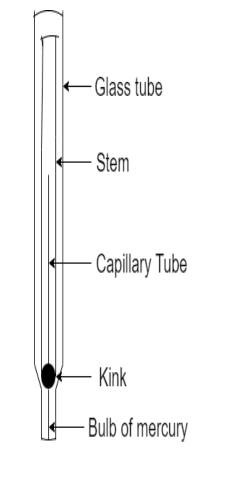
Write a neat diagram of the clinical thermometer and label the parts.
Answer
560.7k+ views
Hint:Recall that the thermometer is a device that is used for measuring temperature. The term temperature of a body determines how hot or cold a body actually is. The word ‘thermometer’ is a combination of two words – ‘thermo’ and ‘meter’. The word ‘thermo’ means ‘heat’ and ‘meter’ means to ‘measure’.
Complete step by step answer:
Step I:
The parts of the thermometer are: Bulb, kink, capillary tube, stem and glass tube.

Step II:
The bulb of the thermometer is spherical in shape. It is the lowest part of the thermometer. The bulb of the thermometer holds mercury. If the temperature of the body is high, then the mercury from the bulb starts rising up.
Step III:
Then there is a kink in the thermometer. It plays an important role as it breaks connection between the mercury in the capillary tube and the bulb. It is like a bend that prevents the falling of mercury from capillary to bulb suddenly.
Step IV:
The capillary tube in the thermometer is the long cylindrical tube. It is connected to the bulb. If the temperature increases, then mercury starts rising and if temperature decreases, the mercury starts falling.
Step V:
The stem is the longest part that has a hollow area which forms the length of the stem. The mercury from the bulb enters the hollow area of the stem when the temperature rises.
Step VI:
The thermometer is made up of a glass tube which is cylindrical in shape.
Note:It is important to note that the liquid thermometers work on the principle of thermal expansion. The solids and liquids expand on heating. When a substance gets hotter, its volume increases. This increase in volume, increases the height of the liquid in the mercury column.
Complete step by step answer:
Step I:
The parts of the thermometer are: Bulb, kink, capillary tube, stem and glass tube.

Step II:
The bulb of the thermometer is spherical in shape. It is the lowest part of the thermometer. The bulb of the thermometer holds mercury. If the temperature of the body is high, then the mercury from the bulb starts rising up.
Step III:
Then there is a kink in the thermometer. It plays an important role as it breaks connection between the mercury in the capillary tube and the bulb. It is like a bend that prevents the falling of mercury from capillary to bulb suddenly.
Step IV:
The capillary tube in the thermometer is the long cylindrical tube. It is connected to the bulb. If the temperature increases, then mercury starts rising and if temperature decreases, the mercury starts falling.
Step V:
The stem is the longest part that has a hollow area which forms the length of the stem. The mercury from the bulb enters the hollow area of the stem when the temperature rises.
Step VI:
The thermometer is made up of a glass tube which is cylindrical in shape.
Note:It is important to note that the liquid thermometers work on the principle of thermal expansion. The solids and liquids expand on heating. When a substance gets hotter, its volume increases. This increase in volume, increases the height of the liquid in the mercury column.
Recently Updated Pages
Master Class 11 Economics: Engaging Questions & Answers for Success

Master Class 11 English: Engaging Questions & Answers for Success

Master Class 11 Social Science: Engaging Questions & Answers for Success

Master Class 11 Biology: Engaging Questions & Answers for Success

Class 11 Question and Answer - Your Ultimate Solutions Guide

Master Class 11 Business Studies: Engaging Questions & Answers for Success

Trending doubts
10 examples of friction in our daily life

One Metric ton is equal to kg A 10000 B 1000 C 100 class 11 physics CBSE

Difference Between Prokaryotic Cells and Eukaryotic Cells

1 Quintal is equal to a 110 kg b 10 kg c 100kg d 1000 class 11 physics CBSE

Explain zero factorial class 11 maths CBSE

What is a periderm How does periderm formation take class 11 biology CBSE




